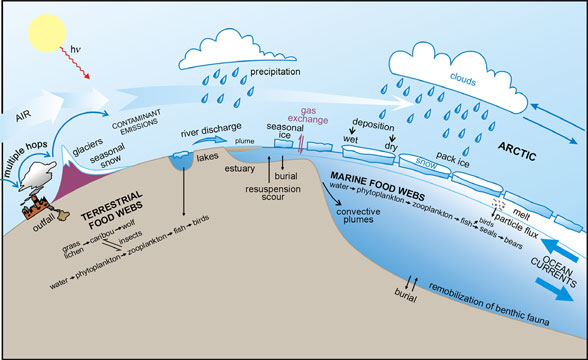Climate Scenarios
Persistent organic pollutants (POPs) and heavy metals are transported to the Arctic via air and oceans. They can be buried in soil and glaciers in the Arctic and be released from these secondary sources by e.g. increased precipitation and erosion as a consequence of higher temperatures.
Models with different climate scenarios can answer questions about how climate change will affect the long-range transport and fate of contaminants. They can also show possible implications for the re-distribution of contaminants (geographically and between environmental media). The transport pathways are illustrated in this figure from MacDonald et al 2005. (AMAP)

Emissions scenarios for greenhouse gases and aerosol concentrations in the atmosphere depend on assumptions for the future development of the human population, energy use, technological changes and other sociological parameters (IPCC, 2000). Concentrations of the external drivers (e.g. greenhouse gas and aerosol concentrations in the atmosphere) of the climate system in the scenario calculations with the global climate models (general circulation models; GCM) can be predicted. Greenhouse gas concentrations do not vary much between the scenarios until the middle of the century. Consequently, the GCM results are similar for the first half of the 21st century, independent of the specific scenario. However, by the end of the 21st century, major differences emerge that exceed the natural fluctuations.
Within the ArcRisk project the ECHAM5/MPI-OM and CCSM3 models in combination with IPCC standard scenarios were chosen for scenario calculation, results and were used. Depending on the requirements in the respective modelling exercises other climate models and/or scenarios were also used.
What do we know for sure about climate change and what are the uncertainties?
To predict scenarios of the future is difficult, and involves a number of uncertainties. There are three main sources of uncertainty to the predictions of climate change; scenario assumptions, model physics, and internal variability. Internal variability and natural cycles have a large effect on the validity of results. Nevertheless, there are several research projects regarding climate change. IPCC publishes reports about climate change, which can be found here.
Models are validated against monitoring data to confirm that the model assumptions lead to reliable results. However, this validation can only be made for the current conditions. With the use of global models, regional and local distribution patterns become uncertain. Thus, regional distribution of pollutants in the Arctic can vary compared to the predictions of the global models.
In a long time perspective, all climate scenarios and models agree on a number of changes. Such parameters are called “certain” (all climate models and all scenarios agree):
- It is getting warmer
- Changed precipitation patterns
- Runoff is increasing
- Sea ice is retreating
- Sea ice volume is decreasing
- Sea ice export/net-thermodynamic growth is decreasing





















